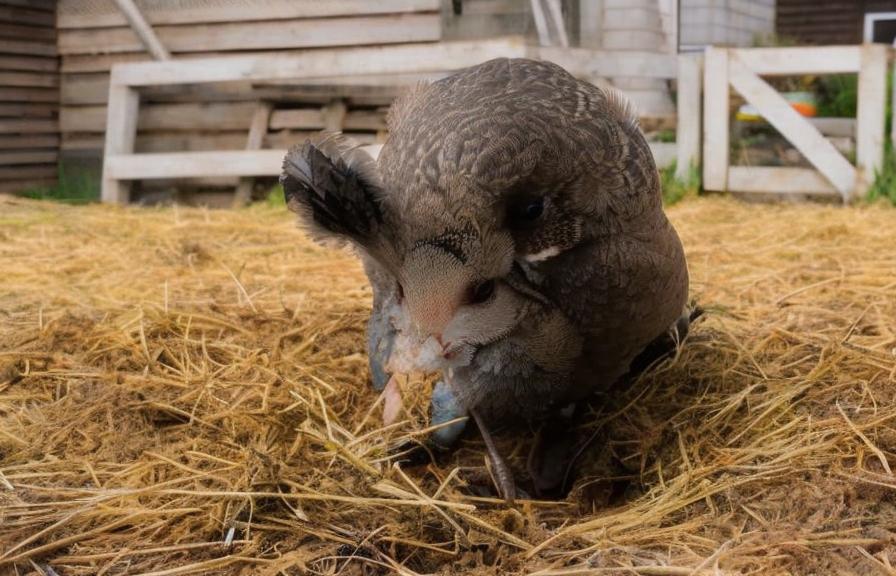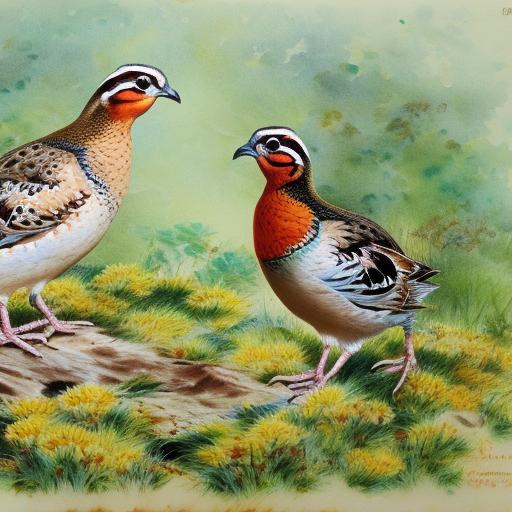Rare quail breeds are a fascinating and often overlooked aspect of the poultry industry. While many people are familiar with common quail breeds such as the Coturnix or Bobwhite, there are numerous rare and unique quail breeds that are prized for their beauty, rarity, and sometimes even their egg-laying abilities. These rare quail breeds come in a variety of colors, patterns, and sizes, making them a popular choice for poultry enthusiasts and breeders looking to add diversity to their flocks. In this article, we will explore the characteristics, history, challenges, conservation efforts, and future prospects of rare quail breeds, shedding light on these often underappreciated birds.
Key Takeaways
- Rare quail breeds are a unique and valuable addition to the poultry industry, offering diversity and potential for conservation efforts.
- Characteristics of rare quail breeds include unique color patterns, smaller size, and distinct vocalizations, making them a popular choice for enthusiasts.
- The history and origin of rare quail breeds can be traced back to different regions around the world, each with its own distinct traits and qualities.
- Challenges in breeding and raising rare quail breeds include genetic diversity, disease resistance, and maintaining purebred lines.
- Conservation efforts for rare quail breeds are crucial to preserving genetic diversity and preventing extinction, with organizations and breeders working together to protect these valuable birds.
Characteristics and Physical Traits of Rare Quail Breeds
Rare quail breeds exhibit a wide range of physical traits and characteristics that set them apart from more common quail breeds. Some rare quail breeds, such as the Silver Range quail, are known for their striking silver plumage and distinctive black markings, while others, like the Tibetan quail, boast a unique combination of brown and white feathers that give them a regal appearance. In addition to their eye-catching plumage, rare quail breeds also come in a variety of sizes, with some breeds being smaller and more compact, while others are larger and more robust. Furthermore, rare quail breeds often have distinct behavioral traits, such as being more flighty or docile compared to their common counterparts. These unique physical and behavioral traits make rare quail breeds a valuable addition to any poultry enthusiast’s collection, providing diversity and beauty to their flocks.
Rare quail breeds also exhibit a wide range of egg-laying abilities, with some breeds being prized for their prolific egg production and others for the unique color or size of their eggs. For example, the Italian “Coturnix” quail is known for its high egg production, making it a popular choice for commercial egg production, while the British Range quail is valued for its large, speckled eggs that are sought after by gourmet chefs and egg enthusiasts. Additionally, rare quail breeds often have distinct vocalizations and calls, adding to their allure and appeal for those looking to add a touch of exoticism to their poultry collection. Overall, the physical traits and characteristics of rare quail breeds make them a captivating and valuable addition to the world of poultry breeding and raising.
History and Origin of Rare Quail Breeds
The history and origin of rare quail breeds are often shrouded in mystery and intrigue, as many of these breeds have ancient origins that date back centuries. Some rare quail breeds have been bred for specific purposes, such as hunting or ornamental display, while others have been developed through natural selection in their native habitats. For example, the Japanese “Coturnix” quail has a long history in Japan, where it was originally bred for its meat and eggs. Over time, different color mutations and variations emerged, leading to the development of rare color varieties such as the Tuxedo and Golden Manchurian quail. Similarly, the Tibetan quail has its origins in the high-altitude regions of Tibet, where it has adapted to the harsh climate and developed its distinctive brown and white plumage.
In addition to their historical significance, rare quail breeds also have cultural importance in many parts of the world. For example, in some Asian countries, quail fighting is a popular pastime, leading to the development of specific quail breeds that are prized for their fighting abilities and aggression. Furthermore, rare quail breeds have been featured in art, literature, and folklore throughout history, adding to their mystique and allure. The rich history and cultural significance of rare quail breeds make them a fascinating subject for poultry enthusiasts and historians alike.
Challenges in Breeding and Raising Rare Quail Breeds
Breeding and raising rare quail breeds comes with its own set of challenges and considerations that differ from those of more common quail breeds. One of the main challenges in breeding rare quail breeds is maintaining genetic diversity and preventing inbreeding, as many rare quail breeds have small population sizes and limited genetic variation. Inbreeding can lead to a host of health issues and genetic abnormalities, making it crucial for breeders to carefully manage breeding programs and avoid close relatives mating with each other. Additionally, rare quail breeds often have specific dietary and environmental requirements that must be met in order to thrive and reproduce successfully. For example, some rare quail breeds may require specialized diets or habitat conditions due to their unique physiological adaptations or behavioral traits.
Another challenge in breeding and raising rare quail breeds is the limited availability of breeding stock and resources, as many rare quail breeds are not widely distributed or readily available in the poultry market. This can make it difficult for breeders to acquire new bloodlines or genetic material to introduce into their breeding programs, leading to potential stagnation in genetic diversity and overall health of the breed. Furthermore, rare quail breeds may be more susceptible to diseases or environmental stressors due to their limited genetic diversity, making it essential for breeders to implement strict biosecurity measures and health protocols to safeguard their flocks. Overall, breeding and raising rare quail breeds requires careful planning, dedication, and a deep understanding of the unique challenges that come with working with these special birds.
Conservation Efforts for Rare Quail Breeds
Conservation efforts for rare quail breeds play a crucial role in preserving these unique birds for future generations and ensuring their continued existence in the poultry industry. Many rare quail breeds are at risk of extinction due to habitat loss, overhunting, or competition from more common quail species, making it imperative for conservation organizations and breeders to work together to protect these valuable genetic resources. One of the main conservation strategies for rare quail breeds is establishing breeding programs that focus on maintaining genetic diversity and promoting sustainable breeding practices. This may involve creating studbooks, implementing breeding guidelines, and coordinating breeding efforts among different breeders to prevent inbreeding and preserve valuable genetic traits.
Furthermore, conservation efforts for rare quail breeds often involve habitat restoration and protection initiatives aimed at preserving the natural environments where these birds originate from. By conserving their native habitats, conservationists can help ensure that rare quail breeds have access to suitable breeding grounds and resources needed for their survival. Additionally, education and outreach programs play a vital role in raising awareness about the importance of conserving rare quail breeds and promoting sustainable practices within the poultry industry. By engaging with the public and sharing information about the value of rare quail breeds, conservation organizations can garner support for their efforts and inspire others to take action in preserving these special birds. Overall, conservation efforts for rare quail breeds are essential for safeguarding their genetic diversity and cultural significance for future generations.
Popular Rare Quail Breeds in the Poultry Industry

Several rare quail breeds have gained popularity in the poultry industry due to their unique characteristics, beauty, or utility. One such breed is the Button quail, also known as Chinese painted quail or King quail, which is prized for its small size, colorful plumage, and gentle disposition. Button quail are often kept as ornamental birds or pets due to their charming appearance and quiet nature, making them a popular choice for aviculture enthusiasts. Another popular rare quail breed is the Snowflake Bobwhite quail, which is known for its striking white plumage with black speckles that resemble snowflakes. Snowflake Bobwhite quail are valued for their beauty and are sometimes kept as exhibition birds or released into the wild for hunting purposes.
In addition to ornamental breeds, some rare quail breeds are sought after for their egg-laying abilities or meat production. For example, the Jumbo Brown Coturnix quail is a popular choice for commercial egg production due to its high egg-laying capacity and fast growth rate. Similarly, the Gambel’s quail is prized by hunters for its flavorful meat and is often raised on game farms for sport hunting purposes. These popular rare quail breeds have carved out a niche in the poultry industry due to their unique qualities and have garnered a dedicated following among poultry enthusiasts and breeders.
Future Prospects for Rare Quail Breeds
The future prospects for rare quail breeds are promising as more attention is being given to their conservation and promotion within the poultry industry. With increased awareness about the value of genetic diversity and heritage breeds, there is growing interest in preserving rare quail breeds as part of efforts to maintain biodiversity in agriculture. Furthermore, advancements in breeding techniques and genetic technologies offer new opportunities for breeders to manage and improve the genetic health of rare quail breeds while maintaining their unique traits.
Additionally, the growing interest in sustainable agriculture and backyard poultry keeping has led to a resurgence in interest in rare quail breeds as people seek out alternative options to common poultry species. This trend has created new market opportunities for rare quail breeds as ornamental birds, specialty egg producers, or niche meat sources. As a result, there is renewed enthusiasm for conserving and promoting rare quail breeds within the poultry industry.
In conclusion, rare quail breeds offer a wealth of diversity, beauty, and cultural significance that enriches the world of poultry breeding and raising. Their unique characteristics, historical importance, conservation needs, popularity within the industry, and promising future prospects make them an invaluable part of our agricultural heritage that deserves recognition and protection. By understanding and appreciating the value of rare quail breeds, we can ensure that these special birds continue to thrive for generations to come.
If you’re interested in rare quail breeds, you might also want to check out Poultry Wizard’s article on whether turkeys need a coop. Understanding the housing needs of different poultry species can provide valuable insights into creating the ideal environment for raising and breeding rare quail breeds.
FAQs
What are rare quail breeds?
Rare quail breeds are varieties of quail that are not commonly found or are less common than popular quail breeds. These breeds may have unique physical characteristics, color patterns, or behaviors that set them apart from more common quail breeds.
What are some examples of rare quail breeds?
Some examples of rare quail breeds include the Tibetan quail, the Mexican speckled quail, the Manchurian quail, the Harlequin quail, and the Silver Tuxedo quail. These breeds may have distinct color patterns or markings that make them stand out from more common quail breeds.
Where can rare quail breeds be found?
Rare quail breeds can be found through specialty breeders, quail enthusiasts, and sometimes through conservation organizations that work to preserve and protect rare quail breeds. They may also be available at select poultry and exotic bird shows or auctions.
Are rare quail breeds suitable for beginners?
Rare quail breeds may require more specialized care and attention compared to more common quail breeds, so they may not be as suitable for beginners. It’s important for potential owners to research the specific needs and requirements of rare quail breeds before deciding to raise them.
What are the conservation efforts for rare quail breeds?
Conservation efforts for rare quail breeds may include breeding programs, habitat preservation, and education about the importance of preserving genetic diversity within quail populations. Some organizations may also work to raise awareness about the threats facing rare quail breeds and advocate for their protection.
Meet Walter, the feathered-friend fanatic of Florida! Nestled in the sunshine state, Walter struts through life with his feathered companions, clucking his way to happiness. With a coop that’s fancier than a five-star hotel, he’s the Don Juan of the chicken world. When he’s not teaching his hens to do the cha-cha, you’ll find him in a heated debate with his prized rooster, Sir Clucks-a-Lot. Walter’s poultry passion is no yolk; he’s the sunny-side-up guy you never knew you needed in your flock of friends!







